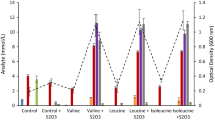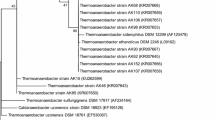Summary
The ability ofAcetobacterium woodii andEubacterium limosum to degrade methyl esters of acetate, propionate, butyrate, and isobutyrate was examined under growing and resting-cell conditions. Both bacteria hydrolyzed the esters to the corresponding carboxylates and methanol under either condition. Methanol was further oxidized to formate under growing but not resting conditions. Unlike the metabolism of phenylmethylethers, no H2 requirement was evident for ester biotransformation. The hydrolysis of methyl carboxylates is thermodynamically favorable under standard conditions and the mixotrophic metabolism of ester/CO2 allowed for bacterial growth. These results suggest that the degradation of methyl carboxylates may be a heretofore unrecognized nutritional option for acetogenic bacteria.
Similar content being viewed by others
References
Avedovech, R.M. Jr., M.R. McDaniel, B.T. Watson and W.E. Sandine. 1992. An evaluation of combinations of wine yeast andLeuconostoc oenos strains in malolactic fermentation of Chardonnay wine. Am. J. Enol. Viti. 43: 253–260.
Bache, R. and N. Pfennig. 1981. Selective isolation ofAcetobacterium woodii on methoxylated aromatic acids and determination of growth yields. Arch. Microbiol. 130: 255–261.
Browning, E. 1965. Toxicity and Metabolism of Industrial Solvents. Elsevier, New York.
Bunton, C.A. and T. Hadwick. 1957. Tracer studies in ester hydrolysis. V. The kinetic form and stereochemical course of the hydrolysis ofp-methoxydiphenylmethyl acetate. J. Chem. Soc. 3043–3047.
Bunton, C.A. and T. Hadwick. 1958. Tracer studies in ester hydrolysis. VI. The hydrolysis of methyl trifluoroacetate. J. Chem. Soc. 3248–3256.
Bunton, C.A., A.E. Comyns, J. Graham and J.R. Quayle. 1955. Preparation and hydrolysis of esters of 2,4,6-triphenylbenzoic acid. II. Mechanisms of hydrolysis. J. Chem. Soc. 3817–3824.
Datta, S.C., J.N.E. Day and C.K. Ingold. 1939. Mechanism of hydrolysis of carboxylic esters and of esterification of carboxylic acids. Acid hydrolysis of an ester with heavy oxygen as isotopic indicator. J. Chem. Soc. 838–840.
de Bruin, A. 1976. Biochemical Toxicology of Environmental Agents. Elsevier, New York.
DeWeerd, K.A., A. Saxena, D.P. Nagle, Jr and J.M. Suflita. 1988. Metabolism of the18O-methoxy substituent of 3-methoxybenzoic acid and other unlabeled methoxybenzoic acids by anaerobic bacteria. Appl. Environ. Microbiol. 54: 1237–1242.
Diekert, G., E. Schrader and W. Harderet. 1986. Energetics of CO formation and CO oxidation in cell suspensions ofAcetobacterium woodii. Arch. Microbiol. 144: 386–392.
Doré J. and M.P. Bryant. 1990. Metabolism of one-carbon compounds by the ruminal acetogenSyntrophococcus sucromutans. Appl. Environ. Microbiol. 56: 984–989.
Euranto, E.K. 1969. Esterification and ester hydrolysis. In: The Chemistry of Carboxylic Acids and Esters (Patai, S., ed.), pp. 505–588, Interscience-Publishers, New York.
Forney, C.F., J.P. Mattheis and R.K. Austin. 1991. Volatile compounds produced by broccoli under anaerobic conditions. J. Agric. Food Chem. 39: 2257–2259.
Frazer, A.C. and L.Y. Young. 1986. Anaerobic C1 metabolism of the O-methyl-14C-labeled substituent of vanillate. Appl. Environ. Microbiol. 51: 84–87.
Inoue, T., T. Takeuchi, N. Hisanaga, Y. Ono, M. Iwata, M. Ogata, K. Saito, H. Sakurai, I. Hara, T. Matsushita and M. Ikeda. 1983. A nationwide survey on organic solvent components in various solvent products: Part 1. Homogeneous products such as thinners, degreasers and reagents. Ind. Health 21: 175–183.
Kreft, J.-U. and B. Schink. 1993. Demethylation and degradation of phenylmethylethers by the sulfide-methylating homoacetogenic bacterium strain TMBS 4. Arch. Microbiol. 159: 308–315.
Kumai, M., A. Koizumi, K. Saito, H. Sakurai, T. Inoue, Y. Takeuchi, I. Hara, M. Ogata, T. Matsushita and M. Ikeda. 1983. A nationwide survey on organic solvent components in various solvent products: Part 2. Heterogeneous products such as paints, inks and adhesives. Ind. Health 21: 185–197.
Leino, M., J. Kaitaranta and H. Kallio. 1992. Comparison of changes in headspace volatiles of some coffee blends during storage. Food Chem. 43: 35–40.
Liu, S. and J.M. Suflita. 1993. H2-CO2-dependent anaerobic O-demethylation activity in subsurface sediments and by an isolated bacterium. Appl. Environ. Microbiol. 59: 1325–1331.
Long F.A. and L. Friedman. 1950. Determination of the mechanism of γ-lactone hydrolysis by a mass spectrometric method. J. Am. Chem. Soc. 72: 3692–3695.
Martin, D.R., L.L. Lundie, R. Kellum and H.L. Drake. 1983. Carbon monoxide-dependent evolution of hydrogen by the homoacetate-fermenting bacteriumClostridium thermoaceticum. Curr. Microbiol. 8: 337–340.
Martin, D.R., A. Misra and H.L. Drake. 1985. Dissimilation of carbon monoxide to acetic acid by glucose-limited cultures ofClostridium thermoaceticum. Appl. Environ. Microbiol. 49: 1412–1417.
Mizunuma, K., T. Kawai, T. Yasugi, S.-I. Horiguchi, O. Iwami and M. Ikeda. 1992. In vitro hydrolysis of methyl acetate, a limitation in application of head-space gas chromatography in biological monitoring of exposure. Toxicol. Lett. 62: 247–253.
Nelson, D.R. and C.L. Fatland. 1992. Novel esters on long-chain methyl-branched alcohols in pupae of the tobacco hornworm. Insect Biochem. Mol. Biol. 22: 99–110.
Ogawa, Y., R. Takatsuki, T. Uema, Y. Seki, K. Hiramatsu, A. Okayama, K. Morrimoto and Z. Kaneko. 1988. Acute optic neuropathy induced by thinner sniffing: inhalation of mixed organic solvent containing methyl alcohol and methyl acetate. Ind. Health 26: 239–244.
Polanyi M. and A.L. Szabo. 1934. Mechanism of hydrolysis. Alkaline saponifications of amyl acetate. Trans. Faraday Soc. 30: 508–512.
Rakov D.Y., N.V. Doronina, Y.A. Trotsenko and R.M. Alieva. 1991. Growth of methylotrophic bacteria on methylacetate. Prikl. Biokhim. Mikrobiol. 27: 584–588.
Salinas, M.R., G. Alonso, G. Navarro and F. Pardo. 1990. Contribution to the study of the major aromatic components in the industrial processing of wine by carbonic maceration of Monastrell grapes: II. Ethyl acetate, isopentyl acetate, methyl acetate, ethyl formate and ethyl propionate. An. Bromatol. 42: 219–226.
Stupperich, E. and R. Konle. 1993. Corrinoid-dependent methyl transfer reactions are involved in methanol and 3,4-dimethoxybenzene metabolism bySporomusa ovata. Appl. Environ. Microbiol. 59: 3110–3116.
Suàrez, M. and C. Duque. 1991. Volatile constituents of Lulo (Solanum vestissimum D.) fruit. J. Agric. Food Chem. 39: 1498–1500.
Suflita, J.M. and M.R. Mormile. 1993. Anaerobic biodegradation of known and potential gasoline oxygenates in the terrestrial subsurface. Environ. Sci. Technol. 27: 976–978.
Tanaka, K. and N. Pfennig. 1988. Fermentation of 2-methoxyethanol byAcetobacterium malicum sp. nov. andpelobacter venetianus. Arch. Microbiol. 149: 181–187.
Thauer, R.K., K. Jungermann and K. Decker. 1977. Energy conservation in chemotrophic anaerobic bacteria. Bacteriol. Rev. 41: 100–180.
Thermodynamics Research Center. 1986. TRC Thermodynamic Tables: Non-hydrocarbons. Thermodynamics Research Center, The Texas A&M University System, College Station, Texas.
Windholz, M. 1983. The Merck Index (10th edn), Merck & Co., Rahway, NJ.
Author information
Authors and Affiliations
Rights and permissions
About this article
Cite this article
Liu, S., Suflita, J.M. Anaerobic biodegradation of methyl esters byAcetobacterium woodii andEubacterium limosum . Journal of Industrial Microbiology 13, 321–327 (1994). https://doi.org/10.1007/BF01569735
Received:
Revised:
Accepted:
Issue Date:
DOI: https://doi.org/10.1007/BF01569735




